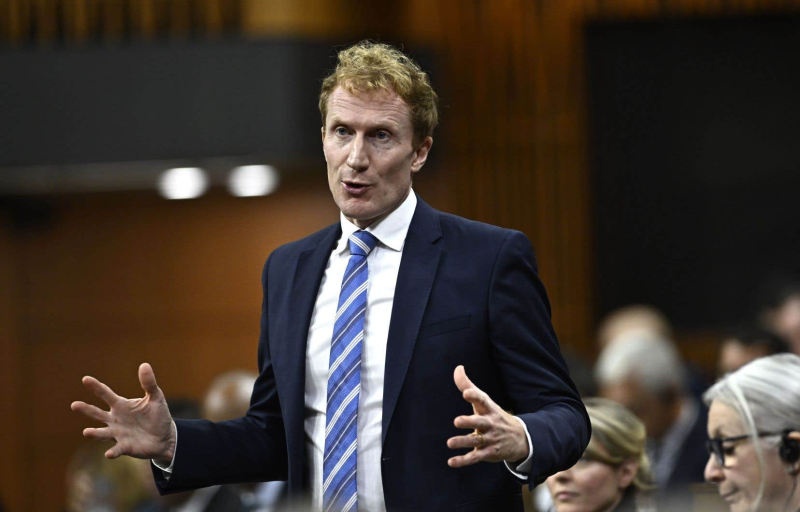
Justin Tang The Canadian Press Federal Minister of Immigration, Marc Miller
The federal Minister of Immigration, Refugees and Citizenship, Marc Miller, will develop a new French-speaking immigration policy outside Quebec “to increase the vitality of French-speaking minority communities.” He made the announcement Tuesday while unveiling new goals to “strengthen” Canada’s immigration system.
“I intend to be ambitious in the targets I will announce over the next few days, but I also want to remain realistic,” the minister said in English. Without giving precise figures, he mentioned a target of 6% French-speaking immigration outside Quebec – more modest than what is claimed – which he could ensure to achieve, even if it means increasing it by year by year.
This rate is still far from that demanded by the Fédération des Communautés francophones et acadienne du Canada, which would like the federal government to set a target of 12% from 2024 which would reach 20% by 2030.
< p>“My goal is to ensure that communities outside Quebec can receive all the people they desperately need to maintain social balance in the bilingual nature of our country,” said Mr. Miller.
Asked about a possible quota applicable to foreign students, including in Quebec, the minister affirmed that he was not considering this option at the moment.
In addition to the new policy, the new Minister of Immigration is committed to implementing a series of measures to improve the current immigration system. These measures include: an immigration system that adapts quickly and responds to global humanitarian crises; improving the Foreign Student Program; integrating the planning of housing, health care, infrastructure and other important services into that of Canada’s immigration levels; and more effective alignment of immigration programs and pathways with worker needs.
“We know that our system needs to be improved,” admitted the minister at a press conference in Ottawa.< /p>
New targets to come
While support for current immigration targets is plummeting, Minister Miller is also due to unveil the new 2024-2026 Immigration Levels Plan on Wednesday. He will thus reveal more details on the number of permanent residents that Canada intends to welcome over the next three years.
In the press scrum on Tuesday, he maintained that he does not “see a scenario where we would reduce [immigration] levels.” He has not yet made any progress on a possible capping or an increase in targets.
“The watchword is a certain stabilization,” he clarified later in the day.
These announcements come as the proportion of Canadians likely to say there are too many immigrants in the country jumped 17 percentage points. Some 27% of Canadians considered last year that “Canada welcomes too many immigrants.” This year, they are 44%, according to a recent survey.
Minister Miller, however, stressed the need to adopt a cautious approach in interpreting this data. “This is not a plea against immigration,” he said, “but rather a plea for us to organize ourselves in a way [other than] in the past. »
“We cannot achieve our ambitious plan for construction, whether in housing or other infrastructure, without newcomers who are specialized in construction,” he added.
The Minister of Public Services and Supply, Jean-Yves Duclos, said he did not fear a “backlash” on the issue. “Canadians, including Quebecers, have always wanted more people to come to the country to help us develop,” he said Tuesday.
Ottawa’s targets have also caused a reaction from the National Assembly on Tuesday.
Parti Québécois MP Pascal Paradis said that although Quebec is “a generous welcoming land,” “a breaking point” may have been reached. “When new arrivals arrive, is there accommodation for them? Are there social services available? Are there jobs that match the qualifications of the newcomers arriving? » asked the elected official.
“There is temporary immigration and permanent immigration. We had a big debate, we will [know the permanent immigration target] tomorrow. But we have never debated the temporary. I think we have to do it,” underlined Québec solidaire MP Guillaume Cliche-Rivard.
More immigrants are leaving the country
While doubt hangs over the new immigration targets to be announced Wednesday, the Canadian Institute for Citizenship has released a report on immigrant retention. His conclusion: more and more of them are leaving Canada.
The researchers notably revealed that 67,000 newcomers left Canada in 2019 and 60,000 in 2017. And on average, 14, 6% left Canada within 15 years of obtaining their permanent resident status.
The report, produced by the Conference Board of Canada, notes that the rate of onward migration, that is to say the percentage of immigrants who leave Canada, has recently reached levels much higher than the historical average.< /p>
These data suggest that these newcomers believe that it is not advantageous to settle in Canada, we can read in the report.
“While the As Canada increasingly relies on immigrants to fill critical shortages in key sectors like housing and health, our ability to retain them becomes a matter of vital national interest,” said Daniel Bernhard, executive director of the Institute for Canadian Citizenship.
In a press scrum on Tuesday, Transport Minister Pablo Rodriguez said that “a lot of discussions” are currently taking place on the immigration retention capacity. “We must make sure to collaborate with the provinces so that they are able [to retain them],” he declared.
With François Carabin

